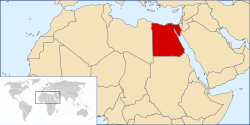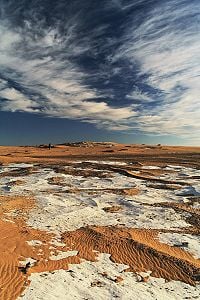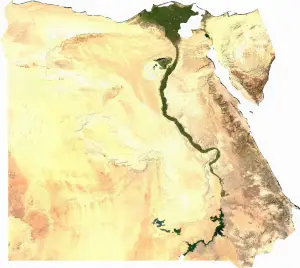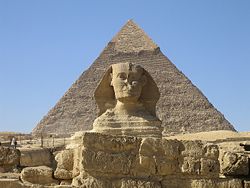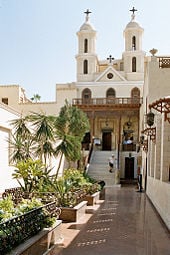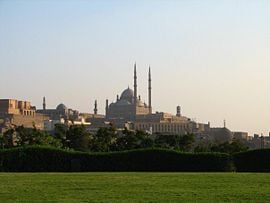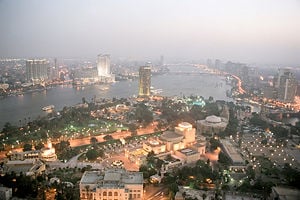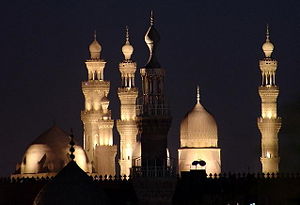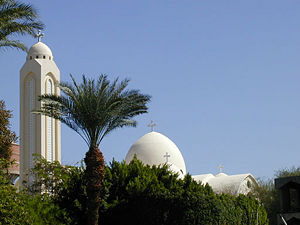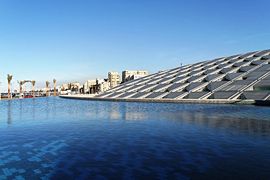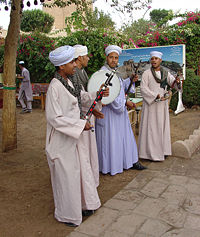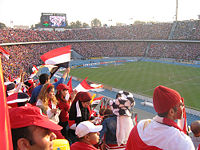Egypt
| جمهورية مصر العربية Gumhūriyyet Maṣr el-ʿArabiyyah Arab Republic of Egypt | |||||
| |||||
| Anthem: Bilady, Bilady, Bilady | |||||
| Capital | Cairo 30°2′N 31°13′E | ||||
|---|---|---|---|---|---|
| Largest city | capital | ||||
| Official languages | Arabic1 | ||||
| Government | Semi-presidential republic | ||||
| - President | Hosni Mubarak | ||||
| - Prime Minister | Ahmed Nazif | ||||
| Establishment | |||||
| - First Dynasty | c.3150 B.C.E. | ||||
| - Independence from UK | February 28 1922 | ||||
| - Republic declared | June 18 1953 | ||||
| Area | |||||
| - Total | 1,001,449 km² (30th) 386,660 sq mi | ||||
| - Water (%) | 0.632 | ||||
| Population | |||||
| - 2007 estimate | 80,335,036 (est.)[1] | ||||
| - 1996 census | 59,312,914 | ||||
| - Density | 74/km² 192/sq mi | ||||
| GDP (PPP) | 2006 estimate | ||||
| - Total | $329.791 billion | ||||
| - Per capita | $4,836 | ||||
| HDI (2006) | |||||
| Currency | Egyptian pound (EGP)
| ||||
| Internet TLD | .eg | ||||
| Calling code | +20 | ||||
Egypt, officially the Arab Republic of Egypt, is a country in North Africa that includes the Sinai Peninsula, a land bridge to Asia. Egypt is one of the most populous countries in Africa. The vast majority of its estimated 78 million people (2007) live near the banks of the Nile River where the only arable agricultural land is found. Large areas of land form part of the Sahara Desert and are sparsely inhabited. Around half of Egypt's residents live in urban areas, with the majority spread across the densely populated centers of greater Cairo, Alexandria, and other major cities in the Nile Delta.
Egypt is famous for its ancient civilization and some of the world's most famous monuments, including the Pyramids and the Great Sphinx; the southern city of Luxor contains a particularly large number of ancient artifacts such as the Karnak Temple and the Valley of the Kings. Today, Egypt is widely regarded as an important political and cultural center of the Middle East.
Geography
Egypt borders Libya to the west, Sudan to the south, the Gaza Strip and Israel to the east. The northern coast borders the Mediterranean Sea and the eastern coast borders the Red Sea. Egypt's important role in geopolitics stems from its strategic position: a transcontinental nation, it possesses a land bridge (the Isthmus of Suez) between Africa and Asia, which in turn is traversed by a navigable waterway (the Suez Canal) that connects the Mediterranean Sea with the Indian Ocean via the Red Sea.
At 386,636 mi² (1,001,450 km²), Egypt is the world's thirtieth-largest country (after Mauritania). It is comparable in size to Tanzania, twice the size of France, four times the size of the UK, and is more than half the size of the U.S. state of Alaska.
Nevertheless, due to the aridity of Egypt's climate, population centers are concentrated along the narrow Nile Valley and Delta, meaning that approximately 99 percent of the population uses only about 5.5 percent of the total land area.
Apart from the Nile Valley, the majority of Egypt's landscape is a big, sandy desert. The winds blowing can create sand dunes over one hundred feet high. Egypt includes parts of the Sahara Desert and of the Libyan Desert. These deserts were referred to as the "red land" in ancient Egypt, and they protected the Kingdom of the Pharaohs from western threats.
Towns and cities include Alexandria, one of the greatest ancient cities, Aswan, Asyut, Cairo, the modern Egyptian capital, El-Mahalla El-Kubra, Giza, the site of the Pyramid of Khufu, Hurghada, Luxor, Kom Ombo, Port Safaga, Port Said, Sharm el Sheikh, Suez, where the Suez Canal is located, Zagazig, and Al-Minya. Oases include Bahariya, el Dakhla, Farafra, el Kharga and Siwa.
Protectorates include Ras Mohamed National Park, Zaranik Protectorate and Siwa.
Climate
Egypt receives the least rainfall in the world. South of Cairo, rainfall averages only around 2 to 5 mm (0.1 to 0.2 in) per year and at intervals of many years. On a very thin strip of the northern coast the rainfall can be as high as 170 mm (7 in), all between November and March. Snow falls on Sinai's mountains and some of its middle and coastal cities.
Temperatures average between 80 and 90 °F (27 - 32 °C) in summer, and up to 109 °F (42 °C) on the Red Sea coast. Temperatures average between 55 and 70 °F (13 to 21 °C) in winter. A steady wind from the northwest helps hold down the temperature near the Mediterranean coast. The Khamaseen is a wind that blows from the south in Egypt, usually in spring or summer, bringing sand and dust, and sometimes raises the temperature in the desert to more than 100 °F (38 °C). Egypt relies on The Nile River for water.
History
The Nile Valley has been a site of continuous human habitation since at least the Paleolithic era. Evidence of this appears in the form of artifacts and rock carvings along the Nile terraces and in the desert oases. In the 10th millennium B.C.E., a culture of hunter-gatherers and fishers replaced a grain-grinding culture. Climate changes and/or overgrazing around 8000 B.C.E. began to desiccate the pastoral lands of Egypt, eventually forming the Sahara Desert. Early tribal peoples migrated to the Nile River where they developed a settled agricultural economy and more centralized society.
By about 6000 B.C.E., organized agriculture and large building construction had appeared in the Nile Valley. During the Neolithic, several predynastic cultures developed independently in Upper and Lower Egypt, remaining somewhat culturally separate but maintaining frequent contact through trade.
A unified kingdom was founded circa 3150 B.C.E. by King Menes, giving rise to a series of dynasties that ruled Egypt for the next three millennia. Egyptian culture flourished during this long period and remained distinct in its religion, arts, language and customs. The first two ruling dynasties of a unified Egypt set the stage for the Old Kingdom period (c. 2700−2200 B.C.E.), famous for its many pyramids.
The First Intermediate Period ushered in a time of political upheaval for about 150 years. Stronger Nile floods and stabilization of government, however, brought back renewed prosperity for the country in the Middle Kingdom c. 2040 B.C.E., reaching a peak during the reign of Pharaoh Amenemhat III. A second period of disunity heralded the arrival of the first foreign ruling dynasty in Egypt, that of the Semitic Hyksos. The Hyksos invaders took over much of Lower Egypt around 1650 B.C.E. They were eventually driven out by an Upper Egyptian force led by Ahmose I, who founded the Eighteenth Dynasty and relocated the capital from Memphis to Thebes.
The New Kingdom (c.1550−1070 B.C.E.) began with the Eighteenth Dynasty, marking the rise of Egypt as an international power that expanded during its greatest extension to an empire as far south as Jebel Barkal in Nubia, and included parts of the Levant in the east. This period is known for some of the most well-known Pharaohs, including Hatshepsut, Thutmose III, Akhenaten and his wife Nefertiti, Tutankhamun and Ramesses II. The first known self-conscious expression of monotheism came during this period in the form of Atenism. Frequent contacts with other nations brought in new ideas in the New Kingdom. The country was later invaded by Libyans, Nubians, and Assyrians, but native Egyptians drove them out and regained control of their country.
The Thirtieth Dynasty was the last native ruling dynasty during the Pharaonic epoch. It fell to the Persians in 343 B.C.E. after the last native Pharaoh, King Nectanebo II, was defeated in battle. Later, Egypt fell to the Greeks and Romans, beginning over two thousand years of foreign rule. Before Egypt became part of the Byzantine realm, Christianity had been brought by Saint Mark the Evangelist in the first century. Diocletian's reign marks the transition from the Roman to the Byzantine era in Egypt, when a great number of Egyptian Christians were persecuted. The New Testament was by then translated into Egyptian, and after the Council of Chalcedon in 451, a distinct Egyptian Coptic Church was firmly established.
The Byzantines were able to regain control of the country after a brief Persian invasion early in the seventh century, until Egypt was invaded in 639 by the Muslim Arabs. The form of Islam the Arabs brought to Egypt was Sunni, though early in this period Egyptians began to blend their new faith with indigenous beliefs and practices that had survived through Coptic Christianity, giving rise to various Sufi orders that have flourished to this day. Muslim rulers nominated by the Islamic Caliphate remained in control of Egypt for the next six centuries, including a period for which it was the seat of the Caliphate under the Fatimids. With the end of the Ayyubid dynasty, a Turco-Circassian military caste, the Mamluks, took control about 1250 and continued to govern even after the conquest of Egypt by the Ottoman Turks in 1517.
The brief French ivasion of Egypt led by Napoleon Bonaparte in 1798 had a great social impact on the country and its culture. Native Egyptians became exposed to the principles of the French Revolution and had an apparent chance to exercise self-governance. A series of civil wars took place between the Ottoman Turks, the Mamluks, and Albanian mercenaries following the evacuation of French troops, resulting in the Albanian Muhammad Ali (Kavalali Mehmed Ali Pasha) taking control of Egypt, where he was appointed as the Ottoman viceroy in 1805. He led a modernization campaign of public works, including irrigation projects, agricultural reforms, and increased industrialization, which were then taken up and further expanded by his grandson and successor Isma'il Pasha.
Following the completion of the Suez Canal by Ismail in 1869, Egypt became an important world transportation hub. In 1866, the Assembly of Delegates was founded to serve as an advisory body for the government. Its members were elected from across Egypt and eventually they came to have an important influence on governmental affairs. The country also fell heavily into debt to European powers. Ostensibly to protect its investments, the United Kingdom seized control of Egypt's government in 1882. Nominal allegiance to the Ottoman Empire continued, however, until 1914. As a result of the declaration of World War I, Britain declared a protectorate over Egypt and deposed the Khedive Abbas II, replacing him with his uncle, Husayn Kamil, who was appointed sultan.
Between 1882 and 1906, a local nationalist movement for independence was taking shape. The Dinshaway Incident prompted Egyptian opposition to take a stronger stand against British occupation and the first political parties were founded. After World War I, Saad Zaghlul and the Wafd Party led the Egyptian nationalist movement after gaining a majority at the local Legislative Assembly. When the British exiled Zaghlul and his associates to Malta in 1919, Egypt witnessed its first modern revolution. Constant revolting by the Egyptian people throughout the country led Great Britain to issue a unilateral declaration of Egypt's independence on February 22, 1922.
The new Egyptian government drafted and implemented a new constitution in 1923 based on a parliamentary representative system. Saad Zaghlul was popularly elected as prime minister of Egypt in 1924, and in 1936 the Anglo-Egyptian Treaty was concluded. Continued instability in the government due to remaining British control and increasing political involvement by the king led to the ouster of the monarchy and the dissolution of the parliament in a military coup d'état known as the 1952 Revolution. The officers, known as the Free Officers Movement, forced King Farouk to abdicate in support of his son Fuad.
The Egyptian Republic was declared on June 18, 1953, with General Muhammad Naguib as the first president. Naguib was forced to resign in 1954 by Gamal Abdel Nasser – the real architect of the 1952 movement – and was later put under house arrest. Nasser assumed power as president and declared the full independence of Egypt from the United Kingdom on June 18, 1956. His nationalization of the Suez Canal on July 26, 1956 prompted the 1956 Suez Crisis. Three years after the 1967 Six Day War, in which Israel had invaded and occupied Sinai, Nasser died and was succeeded by Anwar Sadat.
Sadat switched Egypt's Cold War allegiance from the Soviet Union to the United States, expelling Soviet advisers in 1972, and launched the Infitah economic reform policy, while violently clamping down on religious and secular opposition alike.
In 1973, Egypt, along with Syria, launched the October War, a surprise attack against the Israeli forces occupying the Sinai Peninsula and the Golan Heights in an attempt to liberate the territory Israel had captured six years earlier. Both the United States and the Soviet Union intervened and a cease-fire was reached between both sides. Despite not being a complete military success, most historians agree that the October War presented Sadat with a political victory that would later allow him to pursue peace with Israel. In 1977, Sadat made a historic visit to Israel that led to the 1978 Camp David Accords in exchange for the complete Israeli withdrawal from Sinai. Sadat's initiative sparked enormous controversy in the Arab world and led to Egypt's expulsion from the Arab League but was supported by the vast majority of Egyptians.
Sadat was assassinated in Cairo by a fundamentalist military soldier in 1981 and was succeeded by the incumbent Hosni Mubarak. In 2003, the Egyptian Movement for Change, popularly known as Kifaya, was launched to seek a return to democracy and greater civil liberties.
Politics
Egypt has been a republic since June 18, 1953. President Mohamed Hosni Mubarak has been the president since October 14, 1981, following the assassination of former President Anwar Sadat. Mubarak is currently serving his fifth term in office. He is the leader of the ruling National Democratic Party. Prime Minister Dr. Ahmed Nazif was sworn in as prime minister on July 9, 2004, following the resignation of Dr. Atef Ebeid.
Although power is ostensibly organized under a multi-party semi-presidential system, whereby the executive power is theoretically divided between the president and the prime minister, in practice it rests almost solely with the president, who traditionally has been elected in single-candidate elections. Egypt also holds regular multi-party parliamentary elections. The last presidential election, in which Mubarak won a fifth consecutive term, was held in September 2005.
In late February 2005, President Mubarak announced in a surprise television broadcast that he had ordered the reform of the country's presidential election law, paving the way for multi-candidate polls in the upcoming presidential election. For the first time since the 1952 movement, the Egyptian people had an apparent chance to elect a leader from a list of various candidates. However, the new law placed draconian restrictions on the filing for presidential candidacies, designed to prevent well-known candidates such as Ayman Nour from standing against Mubarak, and paved the road for his easy re-election victory.
Concerns were once again expressed after the 2005 presidential elections about government interference in the election process through fraud and vote-rigging, in addition to police brutality and violence by pro-Mubarak supporters against opposition demonstrators. As a result, most Egyptians are skeptical about the process of democratization and the role of the elections. Less than 25 percent of the country's 32 million registered voters (out of a population of more than 78 million) turned out for the 2005 elections. A proposed change to the constitution would limit the president to two seven-year terms in office.
Thirty-four constitutional changes voted on by parliament on March 19, 2007, prohibit parties from using religion as a basis for political activity; allow the drafting of a new anti-terrorism law to replace the emergency legislation in place since 1981, giving police wide powers of arrest and surveillance; give the president power to dissolve parliament; and end judicial monitoring of elections. It was reported that only 27 percent of registered voters went to the polling stations under heavy police presence and tight political control of the ruling National Democratic Party. It was officially announced on March 27,2007 that 75.9 percent of those who participated in the referendum approved of the constitutional amendments, thus allowing the introduction of laws that curb the activity of certain opposition elements particularly Islamists.
Human rights
Several local and international human rights organizations, including Amnesty International and Human Rights Watch, have for many years criticized Egypt's human rights record as poor. In 2005, President Hosni Mubarak faced unprecedented public criticism when he clamped down on democracy activists challenging his rule. Some of the most serious human rights violations according to HRW's 2006 report on Egypt are routine torture, arbitrary detentions and trials before military and state security courts.
Discriminatory personal status laws governing marriage, divorce, custody and inheritance which put women at a disadvantage have also been cited. Laws concerning Christians which place restrictions on church building and open worship have been recently eased, but major constructions still require governmental approval and persecution of Christianity by underground radical groups remains a problem. In addition, intolerance of Baha'is and unorthodox Muslim sects remains a problem.
The high court of Egypt has outlawed all religions and belief except Islam, Christianity, and Judaism.
Military
The Egyptian Armed forces have a combined troop strength of around 450,000 active personnel. The Egyptian air force is estimated to have roughly the same number of modern warplanes as the Israeli air force and far more Western tanks, artillery, anti-aircraft batteries and warships than the IDF. The Egyptian military has recently undergone massive military modernization, mostly in their air force. Egypt is the first country in the region with a spy satellite, EgyptSat 1, and is planning to launch three more spy satellites.
Foreign relations
Egypt's foreign policy operates along a moderate line. Factors such as population size, historical events, military strength, diplomatic expertise, and a strategic geographical position give Egypt extensive political influence in Africa and the Middle East. Cairo has been a crossroads of regional commerce and culture for centuries, and its intellectual and Islamic institutions are at the center of the region's social and cultural development.
The permanent headquarters of the Arab League is located in Cairo and the Secretary General of the League has traditionally been an Egyptian.The Arab League briefly moved out of Egypt to Tunis in 1978 as a protest at the peace treaty with Israel, but it returned in 1989.
Egypt was the first Arab state to establish diplomatic relations with the state of Israel, after the signing of the Egypt-Israel Peace Treaty. Egypt has a major influence among other Arab states and has historically played an important role as a mediator in resolving disputes between various Arab states and in the Israeli-Palestinian dispute. Most Arab nations still give credence to Egypt playing that role, though its effects are often limited and recently challenged by ambitious Saudi Arabia and oil-rich Gulf states. It is also reported that Egypt's internal problems and its reluctance to play a positive role in regional matters had lost the country great influence in Africa and the neighboring countries.
Former Egyptian Deputy Prime Minister Boutros Boutros-Ghali served as Secretary General of the United Nations from 1991 to 1996.
Administrative divisions
Egypt is divided into twenty-six governorates.
Economy
Egypt's economy depends mainly on agriculture, media, petroleum exports, and tourism. There are also more than three million Egyptians working abroad, mainly in Saudi Arabia, the Persian Gulf, and Europe. The completion of the Aswan High Dam in 1971 and the resultant Lake Nasser have altered the time-honored place of the Nile River in the agriculture and ecology of Egypt. A rapidly growing population, limited arable land, and dependence on the Nile all continue to overtax resources and stress the economy.
The government has struggled to prepare the economy for the new millennium through economic reform and massive investments in communications and physical infrastructure. Egypt has been receiving U.S. foreign aid (since 1979, an average of $2.2 billion per year) and is the third-largest recipient of such funds from the United States. Its main revenues, however, come from tourism as well as traffic that goes through the Suez Canal.
Egypt has a developed energy market based on coal, oil, natural gas, and hydro power. Substantial coal deposits are found in the northeast Sinai and are mined at the rate of about 600,000 tons per year. Oil and gas are produced in the western desert regions, the Gulf of Suez, and the Nile Delta. Egypt has huge reserves of gas, estimated at over 1.1 million cubic meters in the 1990s, and LNG is exported to many countries.
Economic conditions have started to improve considerably after a period of stagnation from the adoption of more liberal economic policies by the government, as well as increased revenues from tourism and a booming stock market. In its annual report, the IMF has rated Egypt as one of the top countries in the world undertaking economic reforms. Some major economic reforms taken by the new government since 2003 include a dramatic slashing of customs and tariffs. A new taxation law implemented in 2005 decreased corporate taxes from 40 percent to 20 percent, resulting in a stated 100 percent increase in tax revenue by the year 2006.
FDI (Foreign Direct Investment) into Egypt has increased considerably in the past few years due to the recent economic liberalization measures taken by minister of investment Mahmoud Mohieddin, exceeding $6 billion in 2006. Egypt was slated to overcome South Africa as the highest earner of FDI on the African continent in 2007.
Although one of the main obstacles still facing the Egyptian economy is the trickle down of wealth to the average population, many Egyptians criticize their government for higher prices of basic goods while their standards of living or purchasing power remains relatively stagnant. Often corruption is blamed by Egyptians as the main impediment to feeling the benefits of the newly attained wealth. Major reconstruction of the country's infrastructure is promised by the government, with a large portion of the sum paid for the newly acquired third mobile license ($3 billion) by Etisalat. This is slated to be pumped into the country's railroad system, in response to public outrage against the government for disasters in 2006 that claimed more than a hundred lives.
The best-known examples of Egyptian companies that have expanded regionally and globally are the Orascom Group and Raya. The IT sector has been expanding rapidly in the past few years, with many new start-ups conducting outsourcing business to North America and Europe, operating with companies such as Microsoft, Oracle, and other major corporations. The sector has been stimulated by new Egyptian entrepreneurs trying to capitalize on their country's huge potential in the sector, as well as constant government encouragement.
Demographics
Egypt is the most populous country in the Middle East and the second-most populous on the African continent, with an estimated 78 million people. Almost all the population is concentrated along the banks of the Nile (notably Cairo and Alexandria), in the Delta and near the Suez Canal.
Approximately 90 percent of the population adheres to Islam and most of the remainder to Christianity (primarily the Coptic Orthodox denomination). Apart from religious affiliation, Egyptians can be divided demographically into those who live in the major urban centers and the fellahin, or farmers of rural villages.
The last forty years have seen a rapid increase in population due to medical advances and massive increases in agricultural productivity.
Egyptians are by far the largest ethnic group in Egypt at 97-98 percent (about 76.4 million) of the total population. Ethnic minorities include the Bedouin Arab tribes living in the eastern deserts and the Sinai Peninsula, the Berber-speaking Siwis (Amazigh) of the Siwa Oasis, and the ancient Nubian communities clustered along the Nile. There are also interspersed communities of Beja concentrated in the southeasternmost corner of the country, and a number of Dom clans mostly in the Nile Delta and Faiyum who are progressively becoming assimilated as urbanization increases.
Egypt also hosts an unknown number of refugees and asylum seekers. According to the UNDP's 2004 Human Development Report, there were 89,000 refugees in the country, though this number may be underestimated. There are some 70,000 Palestinian refugees and about 150,000 recently arrived Iraqi refugees, but the number of the largest group, the Sudanese, is contested.
The once-vibrant Jewish community in Egypt has virtually disappeared, with only a small number remaining in the country, but many Egyptian Jews visit on religious occasions and for tourism. Several important Jewish archaeological and historical sites are found in Cairo, Alexandria, and other cities.
Religion
Religion plays a central role in most Egyptians' lives. The rolling calls to prayer that are heard five times a day have the informal effect of regulating the pace of everything from business to entertainment. Cairo is famous for its numerous mosque minarets and church towers. This religious landscape has been marred by a record of religious extremism. Most recently, a December 16, 2006, judgment of the Supreme Administrative Council of Egypt insisted on a clear demarcation between "recognized religions"—Islam, Christianity, and Judaism—and all other religious beliefs, effectively delegitimizing and forbidding practice of all but these aforementioned religions. This judgment led to the requirement for communities to either commit perjury or be subjected to denial of identification cards.
Egypt is predominantly Muslim, at 90 percent of the population, with the majority being adherents of the Sunni branch of Islam. A significant number of Muslim Egyptians also follow native Sufi orders, and a minority are Shi'ites.
Christians represent 10 percent of the population, most of them members of the native Coptic Orthodox Church of Alexandria. Other native Egyptian Christians are adherents of the Coptic Catholic Church, the Coptic Evangelical Church, and various Coptic Protestant denominations. Non-native Christian communities are largely found in the urban regions of Alexandria and Cairo and are members of the Greek Orthodox Church of Alexandria, the Melkite Greek Catholic Church, the Armenian Apostolic Church, the Roman Catholic Church, the Episcopal Church in Jerusalem and the Middle East, the Maronite Church, the Armenian Catholic Church, the Chaldean Catholic Church, the Syriac Catholic Church, or the Syriac Orthodox Church.
According to the constitution, any new legislation must at least implicitly agree with Islamic laws. The mainstream Hanafi school of Sunni Islam is largely organized by the state, through Wizaret Al-Awkaf (the Ministry of Religious Affairs). Al-Awkaf controls all mosques and overviews Muslim clerics. Imams are trained in imam vocational schools and at Al-Azhar University. The department supports Sunni Islam and has commissions authorized to give fatwa judgments on Islamic issues.
Egypt hosts two major religious institutions. Al-Azhar University is the oldest Islamic institution of higher studies (founded around 970 C.E.) and is considered by many to be the oldest extant university. The Coptic Orthodox Church of Alexandria, headed by the Pope of the Coptic Orthodox Church of Alexandria, attests to Egypt's strong Christian heritage. It has a following of approximately 15 million Christians worldwide; affiliated sister churches are located in Armenia, Ethiopia, Eritrea, India, Lebanon, and Syria.
Religious freedom in Egypt is hampered to varying degrees by extremist Islamist groups and by discriminatory and restrictive government policies. Being the largest religious minority in Egypt, Coptic Christians are the most negatively affected community. Copts have faced increasing marginalization after the 1952 coup d'état led by Gamal Abdel Nasser. Until recently, Christians were required to obtain presidential approval for even minor repairs in churches. Although the law was eased in 2005 by handing down the authority of approval to the governors, Copts continue to face many obstacles in building new or repairing existing churches. These obstacles are not found in building mosques.
In addition, Copts complain of being minimally represented in law enforcement, state security and public office, and of being discriminated against in the workforce on the basis of their religion. The Coptic community, as well as several human rights activists and intellectuals, maintain that the number of Christians occupying government posts is not proportional to the number of Copts in Egypt, who constitute between 10 and 15% of the population in Egypt. However, Copts have demonstrated great success in Egypt's private business sector. Nevertheless, the Coptic community has occasionally been the target of hate crimes and physical assaults.
.
While freedom of religion is guaranteed by the Egyptian constitution, according to Human Rights Watch, "Egyptians are able to convert to Islam generally without difficulty, but Muslims who convert to Christianity face difficulties in getting new identity papers and some have been arrested for allegedly forging such documents. The Coptic community, however, takes pains to prevent conversions from Christianity to Islam due to the ease with which Christians can often become Muslim.
Culture
Egyptian culture has five thousand years of recorded history. Ancient Egypt was among the earliest civilizations and for millennia, Egypt maintained a strikingly complex and stable culture that influenced later cultures of Europe, the Middle East, and Africa. After the Pharaonic era, Egypt itself came under the influence of Hellenism, Christianity, and Islamic culture. Today, many aspects of Egypt's ancient culture exist in interaction with newer elements, including the influence of modern Western culture, itself with roots in ancient Egypt.
When Egypt fell under a series of foreign occupations after 343 B.C.E., each left an indelible mark on the country's cultural landscape. Egyptian identity evolved in the span of this long period of occupation to accommodate two new religions, Christianity and Islam, and a new language, Arabic, and its spoken descendant, Egyptian Arabic. The degree with which these factors are estimated today by different groups in Egypt in articulating a sense of collective identity can vary greatly, and therefore continue to be a source of frequent debate.
Egypt's capital city, Cairo, is Africa's largest city and has been renowned for centuries as a center of learning, culture, and commerce. Egypt has the highest number of Nobel Laureates in Africa and the Arab world. Some Egyptian-born politicians were or are currently at the helm of major international organizations like Boutros Boutros-Ghali of the United Nations and Mohamed El Baradei of the IAEA.
Renaissance
The work of early nineteenth-century scholar Rifa'a et-Tahtawi gave rise to the Egyptian Renaissance, marking the transition from Medieval to Early Modern Egypt. His work renewed interest in Egyptian antiquity and exposed Egyptian society to Enlightenment principles. Tahtawi co-founded with education reformer Ali Mubarak a native Egyptology school that looked for inspiration to medieval Egyptian scholars who themselves studied the history, language and antiquities of Egypt.
Arts
.
The Egyptians were one of the first major civilizations to codify design elements in art. The wall paintings done in the service of the Pharaohs followed a rigid code of visual rules and meanings. Modern and contemporary Egyptian art can be as diverse as any works in the world art scene. The Cairo Opera House serves as the main performing arts venue in the Egyptian capital. Egypt's media and arts industry has flourished since the late nineteenth century, today with more than thirty satellite channels and over one hundred motion pictures produced each year. Cairo has long been known as the "Hollywood of the Middle East;" its annual film festival, the Cairo International Film Festival, has been rated as one of eleven festivals with a top-class rating worldwide by the International Federation of Film Producers' Associations. To bolster its media industry further, especially with the keen competition from the Persian Gulf Arab states and Lebanon, a large media city was built. Some Egyptian actors, like Omar Sharif, have achieved worldwide fame.
Literature
Literature constitutes an important cultural element in the life of Egypt. Egyptian novelists and poets were among the first to experiment with modern styles of Arabic literature, and the forms they developed have been widely imitated throughout the Middle East. The first modern Egyptian novel Zaynab by Muhammad Husayn Haykal was published in 1913 in the Egyptian vernacular. Egyptian novelist Naguib Mahfouz was the first Arabic-language writer to win the Nobel Prize in Literature. Egyptian women writers include Nawal El Saadawi, well known for her feminist activism, and Alifa Rifaat who also writes about women and tradition. Vernacular poetry is perhaps the most popular literary genre amongst Egyptians, represented by such luminaries as Ahmed Fuad Nigm (Fagumi), Salah Jaheen and Abdel Rahman el-Abnudi.
Music
Egyptian music is a rich mixture of indigenous, Mediterranean, African and Western elements. In antiquity, Egyptians were playing harps and flutes, including two indigenous instruments: the ney and the oud. Percussion and vocal music also became an important part of the local music tradition ever since. Contemporary Egyptian music traces its beginnings to the creative work of people such as Abdu-l Hamuli, Almaz and Mahmud Osman, who influenced the later work of Egyptian music giants such as Sayed Darwish, Umm Kulthum, Mohammed Abdel Wahab and Abdel Halim Hafez. These prominent artists were followed later by Amr Diab. He is seen by many as the new age "Musical Legend," whose fan base stretches all over the Middle East and Europe. From the 1970s onwards, Egyptian pop music has become increasingly important in Egyptian culture, while Egyptian folk music continues to be played during weddings and other festivities.
Festivals
Egypt is famous for its many festivals and religious carnivals, also known as mulids. They are usually associated with a particular Coptic or Sufi saint, but are often celebrated by all Egyptians irrespective of creed or religion. Ramadan has a special flavor in Egypt, celebrated with sounds, lights (local lanterns known as fawanees) and much flare that many Muslim tourists from the region flock to Egypt during Ramadan to witness the spectacle. The ancient spring festival of Sham en Nisim has been celebrated by Egyptians for thousands of years, typically between the Egyptian months of Paremoude (April) and Pashons (May), following Easter Sunday.
Sports
Football (soccer) is the de facto national sport of Egypt. Egyptian Soccer clubs El Ahly and El Zamalek are the two most popular teams and enjoy the reputation of long-time regional champions. The great rivalries keep the streets of Egypt energized as people fill the streets when their favourite team wins. Egypt is rich in soccer history as soccer has been around for over 100 years. The country is home to many African championships such as the African Cup of Dreams. However, Egypt national team has not qualified for the FIFA World Cup since 1990.
Squash and tennis are other favorite sports. The Egyptian squash team has been known for its fierce competition in international championships since the 1930s.
External links
- Ancient Egyptian Civilization - Aldokkan
- Rural poverty in Egypt (IFAD)
- Encyclopaedia Britannica's Egypt Country Page
- Egyptian Government Services Portal
- New Projects in Egypt
- Egypt State Information Services
- Egypt Information Portal - available in Arabic and English
- BBC News Country Profile - Egypt
- CIA World Factbook - Egypt
- Amnesty International's 2005 Report on Egypt.
- US State Department - Egypt includes Background Notes, Country Study and major reports
- Business Anti-Corruption Portal Egypt Country Profile
- Congressional Research Service (CRS) Reports regarding Egypt
- {{{2}}} at the Open Directory Project
- Egypt Maps - Perry-Castañeda Map Collection
- Egyptian History (urdu)
- By Nile and Tigris, a narrative of journeys in Egypt and Mesopotamia on behalf of the British museum between the years 1886 and 1913, by Sir E. A. Wallis Budge, 1920 (a searchable facsimile at the University of Georgia Libraries; DjVu & layered PDF format)
- Egypt Online Directory
- The Egyptian Organization for Human Rights
Credits
New World Encyclopedia writers and editors rewrote and completed the Wikipedia article in accordance with New World Encyclopedia standards. This article abides by terms of the Creative Commons CC-by-sa 3.0 License (CC-by-sa), which may be used and disseminated with proper attribution. Credit is due under the terms of this license that can reference both the New World Encyclopedia contributors and the selfless volunteer contributors of the Wikimedia Foundation. To cite this article click here for a list of acceptable citing formats.The history of earlier contributions by wikipedians is accessible to researchers here:
The history of this article since it was imported to New World Encyclopedia:
Note: Some restrictions may apply to use of individual images which are separately licensed.


